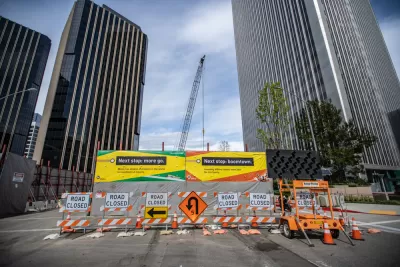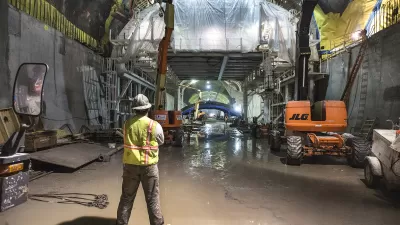Researchers are cataloging the costs of transit projects around the world in an attempt to identify ways to bring costs down and spend transit funding more efficiently.

In an article for Governing, Jared Brey describes the Transit Costs Project, which compares the costs of transit projects around the world to help identify and understand cost variations and how projects can become more cost-effective.
According to the project’s early findings, “The United States is the sixth most expensive country in the world when it comes to building rapid rail projects,” with reasons ranging “from the politicization of project management to the expanding role of consultants, the costs of labor, and efforts to limit disruption to normal traffic flow during construction.”
Governing spoke with project leader Eric Goldwyn, who said, “In the countries that are more expensive than the U.S., they’re building 65 percent or more of their projects underground, and in the U.S., we’re only building like 37 percent of our projects underground. So we’re choosing a less expensive method and we’re still very close to being the most expensive in the world.”
Goldwyn explains that long public review processes drive up costs simply due to inflation, while elaborate station plans also add to costs and reduce the number of stations that can be built under budget. High construction costs matter because they lead to drastically diminished transportation systems and fuel opposition to transit projects.
On what cities are doing right, Goldwyn says “The one thing we see is a heavy emphasis on standardization of design and really trying to economize as much as possible.” When it comes to labor costs, even cities with high worker pay rates can achieve low project costs through labor-saving technologies and other innovations. “It’s not about paying people less. It’s about, don’t spend as many hours doing something, and don’t use as many people to do that thing.”
FULL STORY: Why Are U.S. Transit Projects So Costly? This Group Is on the Case.

Planetizen Federal Action Tracker
A weekly monitor of how Trump’s orders and actions are impacting planners and planning in America.

Congressman Proposes Bill to Rename DC Metro “Trump Train”
The Make Autorail Great Again Act would withhold federal funding to the system until the Washington Metropolitan Area Transit Authority (WMATA), rebrands as the Washington Metropolitan Authority for Greater Access (WMAGA).

DARTSpace Platform Streamlines Dallas TOD Application Process
The Dallas transit agency hopes a shorter permitting timeline will boost transit-oriented development around rail stations.

Texas Moves to Curb Orphan Wells, But Critics Say Loopholes Remain
A proposed state law would shift financial responsibility for sealing unused drilling sites from the public to energy operators, though some advocates question its effectiveness due to industry-backed exemptions.

Affordable Housing Finance 101
The financial intricacies involved in building affordable housing can be difficult to understand. This explainer breaks down the foundational concepts.

San Francisco's School District Spent $105M To Build Affordable Housing for Teachers — And That's Just the Beginning
SFUSD joins a growing list of school districts using their land holdings to address housing affordability challenges faced by their own employees.
Urban Design for Planners 1: Software Tools
This six-course series explores essential urban design concepts using open source software and equips planners with the tools they need to participate fully in the urban design process.
Planning for Universal Design
Learn the tools for implementing Universal Design in planning regulations.
Municipality of Princeton
Roanoke Valley-Alleghany Regional Commission
City of Mt Shasta
City of Camden Redevelopment Agency
City of Astoria
Transportation Research & Education Center (TREC) at Portland State University
US High Speed Rail Association
City of Camden Redevelopment Agency
Municipality of Princeton (NJ)





























